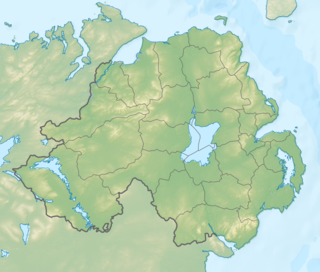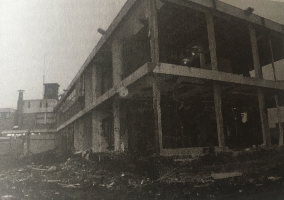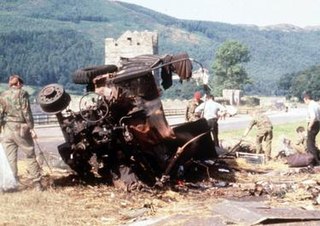 W
WOn Thursday 16 September 1982 the Irish Republican and Revolutionary Socialist paramilitary organization the Irish National Liberation Army (INLA) exploded a bomb hidden in a drainpipe along a balcony in Cullingtree Walk, Divis Tower, Belfast. The explosive device was detonated as a British Army patrol was attacked by a "stone-throwing mob" as they walked along a balcony at Cullingtree Walk. The blast killed three people, a British Army soldier named Kevin Waller (20), and two Catholic civilian passers-by, both of whom were children, they were Stephen Bennet (14) and Kevin Valliday (12). Four other people were injured in the explosion, including another British soldier and three civilians. An INLA member detonated the bomb using a remote control from ground level, where they couldn't see who was on the balcony. There was anger from the Irish Nationalist community directed towards the INLA over the deaths of the two young civilians. 1982 was the INLA's most active year of The Troubles and they killed more British security forces in 1982 than in any other year of the conflict. In December 1982 they carried out the Droppin Well bombing which killed 17 people including 11 off-duty British soldiers, making it the group's deadliest attack against the British Army. INLA Volunteer Martin McElkerney was sentenced to life for the Divis bombing in 1987, but he was released in 1999 under the Good Friday Agreement. In May 2019 McElkerney was found shot, with a handgun nearby, after making a number of concerning phone calls. He later died in hospital.
 W
WOn 24 July 1990 the Provisional IRA (IRA) carried out an IED roadside bomb attack at the Killylea Road on the outskirts of Armagh City, County Armagh, Northern Ireland. An IRA active service unit detonated a large bomb as an unmarked Royal Ulster Constabulary (RUC) vehicle and a civilian car passed, killing three RUC officers and a Catholic nun.
 W
WFrom 6 to 11 July 1997 there were mass protests, fierce riots and gun battles in Irish nationalist districts of Northern Ireland. Irish nationalists/republicans, in some cases supported by the Provisional Irish Republican Army (IRA), attacked the police and British Army. The protests and violence were sparked by the decision to allow the Orange Order to march through a Catholic/nationalist neighbourhood of Portadown. Irish nationalists were outraged by the decision and by the RUC's aggressive treatment of those protesting against the march. There had been a bitter dispute over the march for many years.
 W
WThe Abercorn Restaurant bombing was a paramilitary attack that took place in a crowded city centre restaurant and bar in Belfast, Northern Ireland on 4 March 1972. The bomb explosion claimed the lives of two young women and injured over 130 people. Many of the injuries were severe and included the loss of limbs and eyes. The Provisional IRA was blamed, although no organisation ever claimed responsibility and nobody was ever charged in connection with the bombing. According to Ed Moloney, an Irish journalist who has written extensively about the IRA, republican sources have unofficially confirmed the group's involvement.
 W
WThe Attack on RUC Birches barracks was an attack on 11 August 1986, the East Tyrone Brigade of the Provisional Irish Republican Army (IRA) attacked the Royal Ulster Constabulary (RUC) base at The Birches near Portadown, in North Armagh Northern Ireland. The unmanned base was first raked with gunfire before being completely destroyed by a 200 pounds (91 kg) bomb, which was driven through the gate of the base in the bucket of a JCB digger.
 W
WThe Ballygawley bus bombing was a roadside bomb attack by the Provisional Irish Republican Army (IRA) on a bus carrying British soldiers in Northern Ireland. It occurred in the early hours of 20 August 1988 in the townland of Curr near Ballygawley, County Tyrone. The attack killed eight soldiers and wounded another 28. In the wake of the bombing, the British Army began ferrying its troops in and out of County Tyrone by helicopter.
 W
WThe Ballygawley land mine attack was a bomb attack carried out by the Provisional Irish Republican Army (IRA) on the 13 July 1983. The IRA exploded a landmine under an Ulster Defense Regiment's (UDR) mobile patrol at Ballygawley Road, near Dungannon in County Tyrone, Northern Ireland. Four UDR soldiers were killed in the incident.
 W
WThe Balmoral Furniture Company bombing was a paramilitary attack that took place on 11 December 1971 in Belfast, Northern Ireland. A bomb exploded without warning outside a furniture showroom on the Shankill Road in a predominantly unionist area, killing four civilians, two of them babies. It is widely believed that the bombing was carried out by members of the Provisional Irish Republican Army (IRA) in retaliation for the Ulster Volunteer Force (UVF) bombing of McGurk's Bar a week earlier, which killed 15 Catholic civilians.
 W
WThe Bayardo Bar attack took place on 13 August 1975 in Belfast, Northern Ireland. A unit of the Provisional Irish Republican Army (IRA), led by Brendan McFarlane, launched a bombing and shooting attack on a pub on Aberdeen Street, in the loyalist Shankill area. IRA members stated the pub was targeted because it was frequented by members of the Ulster Volunteer Force (UVF). Four Protestant civilians and one UVF member were killed, while more than fifty were injured.
 W
WOn 19 March 1994, a British Army Lynx helicopter was shot down by the Provisional Irish Republican Army (IRA) in Northern Ireland. A unit of the IRA's South Armagh Brigade fired a heavy improvised mortar at the British Army base in Crossmaglen, County Armagh. The mortar round hit and shot down the helicopter, serial number ZD275, while it was hovering over the helipad. Three British soldiers and a Royal Ulster Constabulary (RUC) member were wounded.
 W
WThe Central Bar bombing was a bomb attack on a pub in the town of Gilford near Portadown in County Down in Northern Ireland on 31 December 1975. The attack was carried out by members of the Irish National Liberation Army (INLA) using the covername "People's Republican Army". Three Protestant civilians were killed in the bombing.
 W
WThe Charlemont pub attacks were co-ordinated militant Loyalist paramilitary attacks on two pubs in the small village of Charlemont, County Armagh, Northern Ireland, carried out by the Ulster Volunteer Force (UVF) on the 15 May 1976. The attacks have been attributed to the Glenanne gang which was a coalition of right-wing Loyalist paramilitaries and subversive members inside the Royal Ulster Constabulary (RUC), the Ulster Defense Regiment (UDR) and the British Army.
 W
WOn the evening of 26 March 1997, the Provisional Irish Republican Army (IRA) East Tyrone Brigade launched an improvised grenade attack on the fortified Royal Ulster Constabulary/British Army base in Coalisland, County Tyrone, Northern Ireland. The blast sparked an immediate reaction by an undercover Special Air Service unit, who shot and wounded Gareth Doris, an Irish republican and alleged IRA volunteer. The SAS unit was then surrounded by a crowd of protesters who prevented them approaching Doris or leaving. RUC officers arrived and fired plastic bullets at the crowd, allowing the special forces to leave the area.
 W
WThe 1992 Coalisland riots were a series of clashes on 12 and 17 May 1992 between local Irish nationalist civilians and British Army soldiers in the town of Coalisland, County Tyrone, Northern Ireland. The Third Battalion 1992 tour's codename was "Operation Gypsy".
 W
WOn 24 November 1991 the Provisional IRA (IRA) detonated an improvised explosive device in the Ulster Loyalist wing of HM Prison Crumlin Road killing two Loyalist prisoners, one from the Ulster Freedom Fighters (UFF) and one from the Ulster Volunteer Force (UVF). This came at the height of a debate on the issues of desegregation between Loyalist and Irish Republican prisoners.
 W
WOn 13 December 1989 the Provisional Irish Republican Army (IRA) attacked a British Army permanent vehicle checkpoint complex manned by the King's Own Scottish Borderers (KOSB) near the Northern Ireland–Republic of Ireland border at Derryard, north of Rosslea, County Fermanagh. The IRA unit, firing from the back of an armoured dump truck, attacked the small base with heavy machine-guns, grenades, anti-tank rockets and a flamethrower. A nearby Army patrol arrived at the scene and a fierce firefight erupted. The IRA withdrew after leaving a van bomb inside the complex, but it did not fully detonate. The assault on the outpost left two soldiers dead and two wounded.
 W
WDuring the evening of 19 December 1975, two coordinated attacks were carried out by the Ulster Volunteer Force (UVF) in pubs either side of the Irish border. The first attack, a car bombing, took place outside Kay's Tavern, a pub along Crowe Street in Dundalk, County Louth, Republic of Ireland - close to the border. The second, a gun and bomb attack, took place at Donnelly's Bar & Filling Station in Silverbridge, County Armagh, just across the border inside Northern Ireland. The attack has been linked to the Glenanne gang, a group of loyalist militants who were either members of the UVF, the Ulster Defence Regiment (UDR), the Royal Ulster Constabulary (RUC) and the closely linked UVF paramilitary the Red Hand Commando (RHC), some of the Glenanne gang were members of two of these organizations at the same time like gang leaders Billy Hanna who was in both the UVF and the UDR and who fought for the British Army during the Korean War and John Weir who was in the UVF and was a sergeant in the RUC. At least 25 UDR men and police officers were named as members of the gang. The Red Hand Commando claimed to have carried out both attacks.
 W
WOn 9 April 1990 the Provisional IRA (IRA) detonated a massive IED roadside bomb under an Ulster Defence Regiment (UDR) mobile patrol which killed four members of the UDR. It was the worst attack against the UDR since seven years previously when, in July 1983, four soldiers of the same regiment were killed in a similar attack near Ballygawley. It was also one of the worst attacks against the security forces in County Down since the Warrenpoint Ambush of August 1979 when 18 British soldiers were killed and six injured.
 W
WThe Dungannon land mine attack was an improvised explosive device attack and shooting against a British Army mobile patrol. The attack was carried out by IRA volunteers from the Provisional IRA's East Tyrone Brigade on 16 December 1979, along the Ballygawley Road, just outside Dungannon in County Tyrone. Four British soldiers who were on mobile patrol were killed in the ambush.
 W
WOn the 24 June 1972, in the small village of Crabarkey near Dungiven town, the Provisional IRA's Derry Brigade detonated a powerful improvised land mine killing three British Army soldiers in a Land Rover while they were on mobile patrol.
 W
WOn 17 July 1975 the South Armagh Brigade of the Provisional IRA (IRA) detonated a land mine when a British Army foot patrol passed over the land mine, killing four British soldiers and seriously injuring another. This was the first major breach in the truce negotiated by the IRA and British government back in February 1975. The attack took place in Forkhill which was right on the Irish border and a safe haven for IRA Volunteers from South Armagh.
 W
WOn 15 June 1988 an unmarked military van carrying six British Army soldiers was blown up by the Provisional Irish Republican Army (IRA) at Market Place in Lisburn, Northern Ireland. The explosion took place at the end of a charity marathon run in which the soldiers had participated. All six soldiers were killed in the attack – four outright, one on his way to hospital and another later on in hospital.
 W
WThe Provisional Irish Republican Army (IRA) carried out two bomb attacks against British coal ships in February 1981 and February 1982 at Lough Foyle, a large inlet between County Londonderry in Northern Ireland and County Donegal in the Republic of Ireland. The IRA used hijacked pilot boats to board the ships. Both vessels were sunk, but their crews reached the coastline safely in lifeboats.
 W
WThe Miami Showband killings was an attack on 31 July 1975 by the Ulster Volunteer Force (UVF), a loyalist paramilitary group. It took place on the A1 road at Buskhill in County Down, Northern Ireland. Five people were killed, including three members of The Miami Showband, who were one of Ireland's most popular cabaret bands.
 W
WOn 4 September 1985, the Provisional IRA fired mortar bombs at a Royal Ulster Constabulary (RUC) base and training centre in Enniskillen, County Fermanagh. Nobody was killed, but 30 people were injured in the attack and the base, which was mainly used to train new recruits, was very badly damaged. The IRA hoped to repeat the success they had earlier in the year when Newry RUC station was attacked with mortars and nine RUC officers were killed and almost 40 injured. It was one of numerous IRA mortar attacks on British Army and RUC bases around this time period.
 W
WThe Mullacreevie ambush took place on 1 March 1991, when a mobile patrol of the Ulster Defence Regiment composed of two Land Rover vehicles was attacked with an improvised horizontal mortar by a Provisional IRA active service unit from the North Armagh Brigade while passing near Mullacreevie housing estate, on the west side of Armagh City. One member of the UDR was killed instantly when the leading Land Rover was hit, while another died of wounds two days later. Two other soldiers were maimed for life.
 W
WOn 2 November 1991, a bomb planted by the Provisional IRA exploded in the Military Wing at Musgrave Park Hospital, Belfast. Two British soldiers were killed and 11 other people were injured, among them a five-year-old girl and a baby of four months.
 W
WOn 22 August 1972 a bomb planted by the Provisional Irish Republican Army, an Irish republican paramilitary group, detonated prematurely at a customs office in Newry. Three IRA members killed six civilians and themselves in the explosion. The event was one of the bloodiest of 1972, the deadliest year of The Troubles.
 W
WOn 28 February 1985, the Provisional Irish Republican Army (IRA) launched a heavy mortar attack on the Royal Ulster Constabulary (RUC) base at Corry Square in Newry, County Armagh, Northern Ireland. The attack killed nine RUC officers and injured almost 40 others; the highest death toll ever suffered by the RUC. Afterwards, a major building scheme was begun to give police and military bases better protection from such attacks.
 W
WThe Newtownhamilton bombing was a carbombing carried out by the Irish National Liberation Army (INLA) on 24 June 1998 in the Armagh border village of Newtownhamilton shortly after the signing of the 1998 Good Friday Agreement by the Irish government, British government Nationalist and Unionist parties as well as parties which represented Republican and Loyalist paramilitaries. The INLA and its political wing the IRSP were opposed to the agreement. The bombing was one of the last actions carried out or claimed by the INLA during the 30-year conflict known as the Troubles.
 W
WThe bombing of RFA Fort Victoria took place on 6 September 1990, when a unit of the Provisional Irish Republican Army (IRA) planted two bombs aboard the Royal Fleet Auxiliary replenishment ship at Harland and Wolff shipyard in Belfast, Northern Ireland, where the vessel had been launched four months before. One of them exploded in the engine room, causing flooding and serious damage. The second device didn't explode and was defused several days later. The attack resulted in a two-year delay before Fort Victoria became fully operational.
 W
WThe Strand Bar Bombing was a gun and bomb attack carried out by the Loyalist Paramilitary organisation the Red Hand Commando, a group closely linked to the Ulster Volunteer Force (UVF) ) in Belfast in 1975. The blast destroyed most of the building and killed six civilians and injured about 50 more.
 W
WThe Teebane bombing took place on 17 January 1992 at a rural crossroads between Omagh and Cookstown in County Tyrone, Northern Ireland. A roadside bomb destroyed a van carrying 14 construction workers who had been repairing a British Army base in Omagh. Eight of the men were killed and the rest were wounded. The Provisional Irish Republican Army (IRA) claimed responsibility, saying that the workers were killed because they were "collaborating" with the "forces of occupation".
 W
WThe Warrenpoint ambush, also known as the Narrow Water ambush, the Warrenpoint massacre or the Narrow Water massacre, was a guerrilla attack by the Provisional Irish Republican Army (IRA) on 27 August 1979. The IRA's South Armagh Brigade ambushed a British Army convoy with two large roadside bombs at Narrow Water Castle outside Warrenpoint, Northern Ireland. The first bomb was aimed at the convoy itself, and the second targeted the incoming reinforcements and the incident command point (ICP) set up to deal with the incident. IRA volunteers hidden in nearby woodland also allegedly fired on the troops, who returned fire. The castle is on the banks of the Newry River, which marks the border between Northern Ireland and the Republic of Ireland.